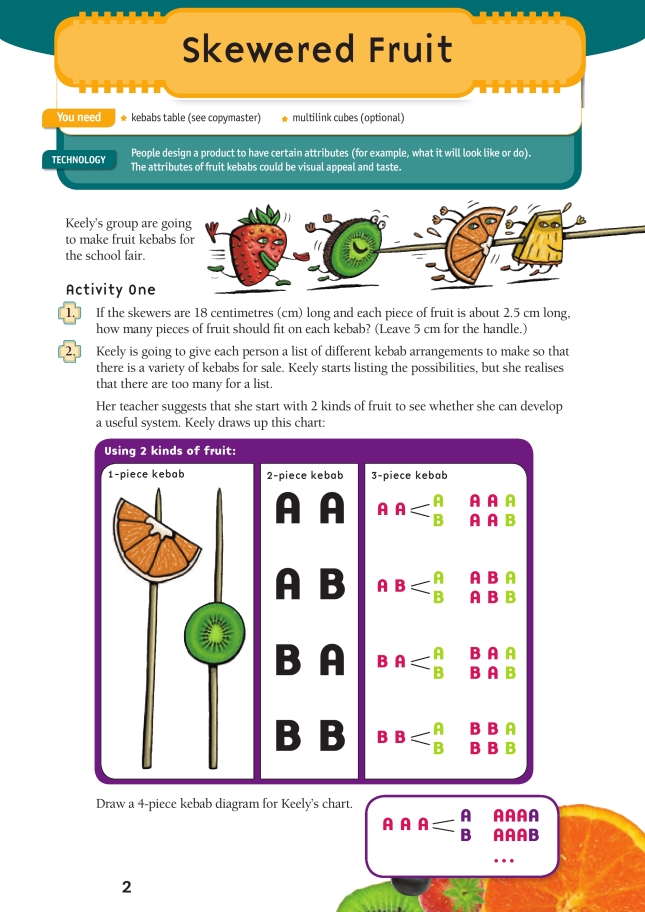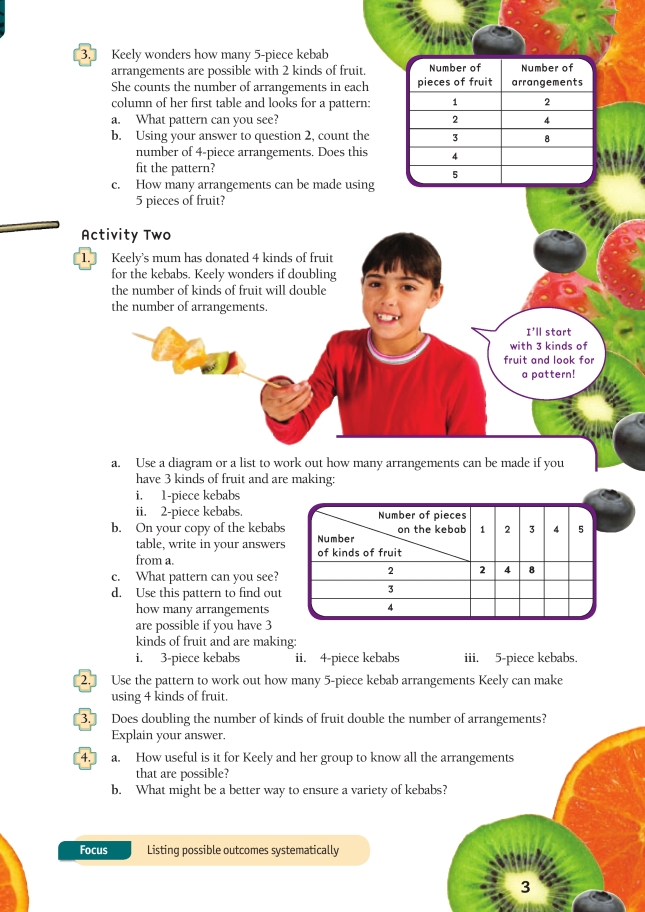This is a level 3 activity from the Figure It Out series.
A PDF of the student activity is included.
Click on the image to enlarge it. Click again to close. Download PDF (752 KB)
Making a generalisation involves identifying a pattern and using it to establish a general rule. In these activities, students are challenged to find numbers of arrangements for pieces of fruit on a kebab. By exploring the pattern that occurs as the number of pieces of fruit is increased, students can discover a general rule that will work for any number of pieces. The process of making generalisations is a core component of mathematical reasoning.
FIO, Technology Rules!, Levels 2+-3+, Skewered Fruit, pages 2 - 3
kebabs table (see copymaster)
In this activity, students list arrangements of fruit on a kebab.
Initially, materials such as multilink cubes can help students to identify different arrangements of fruit pieces. When the number of fruit pieces (or kinds of fruit used) is small, using a systematic approach to identify all the possibilities is less important. However, as the number of fruit pieces increases, it becomes very difficult to keep track of all possibilities.
Note: Concrete examples are very important for English language learners to model and demonstrate the language. You can use the cubes to help you model and explain some of the language.
Explore the first table with your students, helping them to make a link between the 2-piece kebab arrangements and the 3-piece arrangements.
For example, Keely’s chart shows that AB gives ABA and ABB. Encourage the students to use a similar approach to find the number of 2-piece and 3-piece arrangements that can be made using 3 pieces of fruit. For example, have them write down all the 1-piece arrangements (A, B, C). To find the 2-piece arrangements, they add an A, B, and C to each of the 1-piece arrangements (AA, AB, AC, BA, BB …). To find the 3-piece arrangements, they add an A, B, and C to each of the 2-piece arrangements (AAA, AAB, AAC, ABA, ABB, ABC …).
In Activity Two, the focus shifts from listing arrangements to exploring the number of possible arrangements. As the amount of fruit increases, creating a systematic list of all the possibilities becomes impractical. Students are asked to use patterns to find a rule that can be used to work out the number of possible arrangements for any number of fruit. Solving a complex problem by exploring patterns is a powerful problem-solving skill and a key component of mathematical thinking.
Encourage the students to use mathematical language to describe the rule and their reasoning. For example, a conjecture (a statement that you believe to be true but have not yet proved) could be that “the number of arrangements is the number of pieces of fruit multiplied by the number of kinds of fruit”. This rule appears to work for the first two values in the table.
A counter-example (an example that shows that a conjecture is false) is that there are 8 arrangements for a 3-piece kebab using 2 kinds of fruit, not 6.
Extension
Once a rule has been identified, the next step is to explore why the pattern exists, relating it back to the original situation. Ask the students to explain why, when using two kinds of fruit, the number of arrangements doubles each time a new piece of fruit is added. They may find it helpful to relate the rule back to the 3-piece kebab example in the student book.
Finding and using a model and generalising ideas develops the key competency thinking.
Support for English Language Learners
Supporting students with using and understanding descriptions of rules and reasoning
To support your students, especially English language learners, you could model and record the vocabulary, using a speaking frame to show some ways they can describe a rule and their reasoning.
- Use the multilink cubes to model and explain vocabulary such as arrangements, variety, and pieces.
- Model a sentence that describes a conjecture (not using the fruit skewers example). Then record and display your sentence in a graphic organiser like the one below.
Conjecture Reasoning Counter-example or confirmation My conjecture is that if I double the perimeter of a square, the area will also double. (The underlined words can be substituted.)
Changing the size affects length and area in the same way. A square with a perimeter of 4 has an area of 1, but a square with a perimeter of 8 has an area of 4. 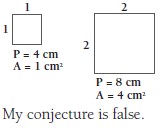
- Erase the optional parts of the sentence describing a conjecture and work with students to co-construct a new sentence by filling in the gaps.
- Repeat the process with a sentence giving the reasoning and a counter-example or confirmation.
- Tell the students to talk in pairs, referring to the frame and making notes or writing sentences in their own graphic organisers as they are describing their conjectures, reasoning, and so on.
- Ask the pairs to share their ideas with the class.
Note that opportunities to repeat and recycle language in different contexts and over time are very important for English language learners. Working with other contexts that use arrangements could be useful.
Technology-related student activities
- Examine everyday items and make a list of their attributes (for example, a jacket, a car, a chair, shoes, or a food item).
- Rank attributes of similar items. For example, examine food packets and rank them in terms of their customer appeal or compare the extent to which different materials are waterproof.
- Examine an everyday item and attempt to list specifications. For instance, estimate the length, weight, and height of a desk and check your results.
- Interview an expert on the attributes and/or specifications of specific items (for example, commercial pizza, hāngi food, safety clothing).
Exploring the technology-related context
Some people confuse attributes with specifications. Attributes are the general properties of a product. For example, fruit kebabs can be colourful and fresh; a coat can be waterproof, warm, or colourful; a car can be fuel-efficient; and a meal can be tasty and nutritious. Specifications are more measurable. For example, a biscuit may contain 280 kilojoules. Attributes and specifications are linked. For example, for a meal to be considered healthy, it would need to meet criteria for kilojoule, salt, and fat content.
Answers
Activity One
1. 5. 18 cm – 5 cm for the handle leaves 13 cm. If each fruit is 2.5 cm long, then 5 pieces will be 12.5 cm.
2. 4-piece kebab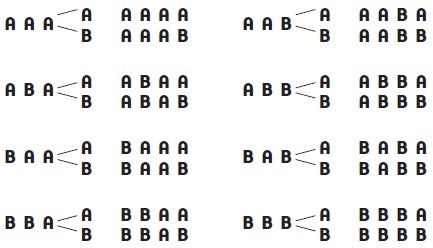
3. a. The number of arrangements doubles for each additional piece of fruit.
b. Yes, the number of arrangements is 16, which is double that for 3 pieces.
c. 32 arrangements.
Activity Two
1. a. i. 3
ii. 9
b. Practical activity
c. If you have 2 kinds of fruit, the number of arrangements doubles each time you add a new piece of fruit. If you have 3 kinds of fruit, the number of arrangements is multiplied by 3 (tripled) each time a new piece of fruit is added.
d. 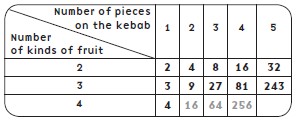
2. 1 024 (4 x 4 x 4 x 4 x 4). See the last line of the table for the numbers of arrangements using 4 types of fruit.
3. No, doubling the number of kinds of fruit more than doubles the number of arrangements. The number of kinds of fruit is the factor by which the pattern goes up, so for 4 kinds of fruit you multiply by 4.
4. a. Keely realises that there are far too many arrangements for her to list them all. Even if she did spend hours doing this, some of the arrangements are less interesting than others because they have so little variety; for example, a kebab made using 5 pieces of apple is far less appealing than a kebab with 3 kinds of fruit. Many arrangements will look identical to the customers, for example, A B A B will look the same as B A B A.
b. People will be more interested in the variety of fruit than in the way the fruit pieces are arranged. Keely could give each of her friends a different combination of fruit pieces to use (for example, 2 pieces of apple, 2 pieces of pineapple, and 1 piece of kiwifruit) and let them decide for themselves how to arrange them.
Keely may have more of one type of fruit than another. This will also influence which arrangements the group makes.
